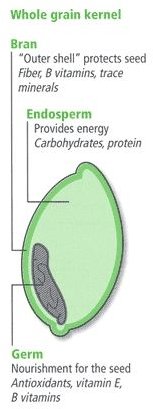What Are Whole Grains and What Are Their Health Benefits?
Health Benefits of Whole Grains

What Are Whole Grains?
Whole grain refers to a grain (such as wheat, barley, corn, oats, or rye) milled in its entirety (not refined); only the inedible parts are removed.
Image: Whole Grain Kernel (click on image to enlarge)
To get a better understanding of what whole grains are, let us look at how bread is made.
The part of the wheat plant that is made into flour and then into bread (and other baked goods) is the kernel. The kernels are separated from the stem of the plant and then broken apart by the milling process.
The kernel has three main parts: the germ, the bran, and the endosperm. The germ is the part of the kernel (plant) that reproduces so it is especially rich in nutrients to support new life. The bran, similar to a nut shell, is the kernel’s protective coating and is also rich in nutrients and fiber. The endosperm is the soft portion inside of the kernel that contains starch and proteins which provides energy to the plant.
In earlier times, people milled the kernel into flour by grinding it between two stones. This would include all parts of the kernel in the final product, resulting in a crunchy, dark-brown “old fashioned” flour. As improvements were made in milling machinery, a whiter, smooth-textured flour resulted.
People were thrilled with white bread but at the time they did not realize many nutrients were removed to make this more appealing bread. Whole grains use the whole kernel (germ, bran, and endosperm). White flour uses only the endosperm (the germ and bran are removed during milling).
Many people were suffering from deficiencies of the nutrients iron, thiamin, niacin, and riboflavin, which they had formerly received from whole grain bread. The Enrichment Act of 1942 standardized the return of these lost nutrients to commercial flour. Original white bread (refined) is now known as refined, enriched bread.
Although iron, thiamin, niacin, and riboflavin are restored, many other nutrients are not. Whole grain items (including breads, cereals, rice, and pasta) are preferred over enriched products because they contain more magnesium, zinc, folate, vitamin B6, vitamin E, chromium, fiber, and many other nutrients.
What Are the Health Benefits of Whole Grains?
Now that you know “what are whole grains”, lets see what the health benefits are.
Whole grains can decrease blood pressure, cholesterol levels, and blood coagulation which can greatly reduce ones risk of heart disease. They help keep the gastrointestinal tract healthy, regulate blood sugar levels, and reduce ones risk of developing many types of cancer. Eating whole grains can also help with weight loss and maintenance.
What Should I Know when Buying Whole Grains?
When buying packaged food products containing grains, look for the word “whole”.
“Stone-ground”, “multigrain”, “100% wheat”, “bran”, or “seven grain” are usually not whole grains.
If the product is brown, it does not necessarily mean it is a whole grain. Many breads are colored brown (usually with molasses) to look like whole grain breads.
Disclaimer
Please read this disclaimer regarding the information contained within this article.